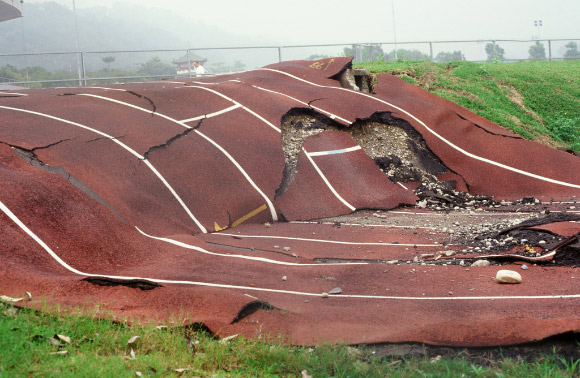A big earthquake can not only cause other quakes, but large ones, and on the opposite side of our planet, according to new research from Oregon State University.

O’Malley et al find quakes can systematically trigger other ones on opposite side of the globe. This image shows a high school running track in Taiwan crossed by the Chelungpu fault in an earthquake in September 1999. Image credit: Bob Yeats, Oregon State University.
Dr. Robert O’Malley from the Department of Botany of Plant Pathology at Oregon State University and co-authors looked at 44 years of seismic data and found clear evidence that tremblors of magnitude 6.5 or larger trigger other quakes of magnitude 5.0 or larger.
It had been thought that aftershocks — smaller magnitude quakes that occur in the same region as the initial quake as the surrounding crust adjusts after the fault perturbation — were the only seismic activity an earthquake could lead to.
But the team’s analysis of seismic data from 1973 through 2016 provided the first discernible evidence that in the three days following one large quake, other earthquakes were more likely to occur.
Each test case in the study represented a single three-day window ‘injected’ with a large-magnitude (6.5 or greater) earthquake suspected of inducing other quakes, and accompanying each case was a control group of 5,355 three-day periods that didn’t have the quake injection.
“The test cases showed a clearly detectable increase over background rates,” Dr. O’Malley said.
“Earthquakes are part of a cycle of tectonic stress buildup and release. As fault zones near the end of this seismic cycle, tipping points may be reached and triggering can occur.”
The higher the magnitude, the more likely a quake is to trigger another quake.
Higher-magnitude quakes, which have been happening with more frequency in recent years, also seem to be triggered more often than lower-magnitude ones.
A tremblor is most likely to induce another quake within 30 degrees of the original quake’s antipode — the point directly opposite it on the other side of the globe.
“The understanding of the mechanics of how one earthquake could initiate another while being widely separated in distance and time is still largely speculative,” Dr. O’Malley said.
“But irrespective of the specific mechanics involved, evidence shows that triggering does take place, followed by a period of quiescence and recharge.”
The results were published in the August 2, 2018 edition of the journal Scientific Reports.
_____
Robert T. O’Malley et al. 2018. Evidence of Systematic Triggering at Teleseismic Distances Following Large Earthquakes. Scientific Reports 8, article number: 11611; doi: 10.1038/s41598-018-30019-2







